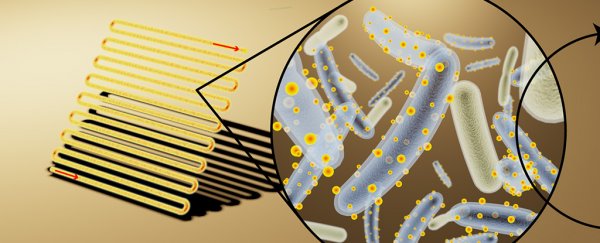In an effort to improve the efficiency of natural photosynthesis, a researcher at the University of California, Berkeley, has created cyborg bacteria.
These bacteria were trained to grow and cover their bodies with tiny semiconductor nanocrystals that act as efficient solar panels for harvesting sunlight.
Although most life on Earth relies upon photosynthesis as its source of energy, the process has a weak link: chlorophyll. Plants and other organisms use the green pigment to harvest sunlight during photosynthesis, but it is rather inefficient.
To that end, scientists have been searching for ways to upgrade natural photosynthesis so humans would be able to capture and use energy from the Sun more efficiently.
Now, Kelsey K. Sakimoto, a researcher at Peidong Yang's lab at the University of California, Berkeley, has come up with a new alternative to natural photosynthesis: cyborg bacteria that were trained to cover themselves in solar panels that are much more efficient than chlorophyll at converting sunlight into useful compounds.
"Rather than rely on inefficient chlorophyll to harvest sunlight, I've taught bacteria how to grow and cover their bodies with tiny semiconductor nanocrystals," Sakimoto said in a press release.
"These nanocrystals are much more efficient than chlorophyll and can be grown at a fraction of the cost of manufactured solar panels."
 Kelsey K. Sakimoto
Kelsey K. Sakimoto
Above you can see an artist's rendering of a bioreactor (left) loaded with bacteria decorated with cadmium sulphide, light-absorbing nanocrystals (middle) to convert light, water and carbon dioxide into useful chemicals (right).
To produce his cyborg bacteria, Sakimoto fed them the amino acid cysteine and the element cadmium.
The bacteria then synthesised cadmium sulfide (CdS) nanoparticles, which efficiently absorb light, functioning as solar panels on the bacteria's surfaces.
The new hybrid organism, called M. thermoacetica-CdS, produces useful acetic acid from light energy, water, and CO2 at a rate that outperforms any sources of natural photosynthesis.
Today, Sakimoto is presenting his work at the 254th National Meeting and Exposition of the American Chemical Society (ACS).
Humanity is facing an ever-growing need for alternatives to fossil fuels as we face down the consequences of greenhouse gas emissions and a rapidly increasing population that requires energy to sustain.
Artificial photosynthesis is not a new concept, and a system that requires only sunlight and simple organic chemicals to generate renewable energy cheaply and cleanly is understandably highly desirable.
While some limited progress has been made in this area, until now, no proposed solution has been nearly efficient enough to warrant commercial use.
Sakiomoto's bacteria, however, operate at an efficiency of more than 80 percent and are both self-replicating and self-regenerating, making this a zero-waste technology with multiple uses.
"Once covered with these tiny solar panels, the bacteria can synthesise food, fuels, and plastics, all using solar energy," he explained.
"These bacteria outperform natural photosynthesis."
While he does acknowledge that more research is needed, Sakiomoto is hopeful that his cyborg bacteria could prove to be a viable alternative to fossil fuels, helping the world produce energy more cheaply and cleanly.
This article was originally published by Futurism. Read the original article.
